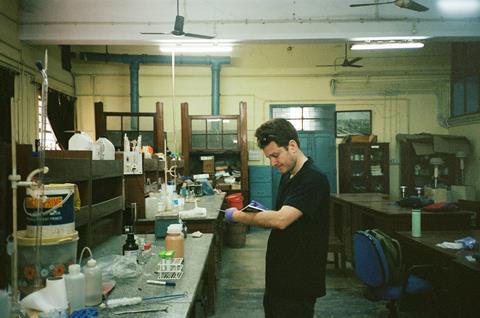In case you missed it: Six big solar stories in the news this week – pv magazine USA

Weekly Report on Solar Industry Developments and Sustainable Development Goal (SDG) Implications
I. Technology and Market Performance
-
Residential Solar Panel Lifespan
- An analysis of the factors affecting the productive lifespan of residential solar panels has been initiated. This inquiry is critical for evaluating the long-term viability and resource efficiency of solar technology, directly impacting SDG 7 (Affordable and Clean Energy) and SDG 12 (Responsible Consumption and Production) by ensuring sustainable infrastructure and minimizing waste.
-
Tesla Energy Division Profitability
- Tesla’s energy division has emerged as its most profitable segment in 2025, contributing 23% of total profit from 13% of revenue. This development underscores the growing economic viability of the clean energy sector, advancing SDG 8 (Decent Work and Economic Growth) and SDG 9 (Industry, Innovation, and Infrastructure) by demonstrating a profitable business model for sustainable technologies that support SDG 7 (Affordable and Clean Energy).
II. Policy, Regulation, and Energy Access
-
Reversal of “Solar For All” Funding
- The Environmental Protection Agency (EPA) under the Trump administration is set to retract $7 billion in grant funds allocated for the “Solar For All” program. This action directly threatens initiatives designed to provide solar energy access to low- and moderate-income families, posing a significant setback to achieving SDG 1 (No Poverty), SDG 7 (Affordable and Clean Energy), and SDG 10 (Reduced Inequalities).
-
Judicial Review of California’s Net Metering Policy
- The California Supreme Court has mandated a re-examination of the state’s net energy metering 3.0 policy by an appeals court. The policy’s initial implementation led to a severe decline in the rooftop solar market, jeopardizing the state’s ability to meet its clean energy targets. This judicial review is a crucial step toward potentially realigning state policy with SDG 7 (Affordable and Clean Energy), SDG 11 (Sustainable Cities and Communities), and SDG 13 (Climate Action).
-
Proposal for Rapid Renewable Energy Expansion in California
- A policy proposal outlines a strategy for California to add 23 GW of renewable energy capacity near existing thermal generator sites. This ambitious plan aims to leverage existing infrastructure and expiring tax credits to accelerate the state’s transition to clean energy, significantly contributing to SDG 7 (Affordable and Clean Energy), SDG 9 (Industry, Innovation, and Infrastructure), and SDG 13 (Climate Action).
III. Supply Chain and International Trade
-
Detention of Qcells Solar Imports
- U.S. Customs and Border Protection (CBP) has detained solar cell imports from South Korea manufactured by Qcells. The company asserts that its supply chain is free from materials originating in the Xinjiang province of China and is working with CBP for a resolution. This event highlights the critical importance of transparent and ethical supply chains, a core tenet of SDG 12 (Responsible Consumption and Production) and SDG 8 (Decent Work and Economic Growth), particularly concerning the eradication of forced labor. It also underscores the role of strong institutions in enforcing international standards, as per SDG 16 (Peace, Justice and Strong Institutions).
Identified Sustainable Development Goals (SDGs)
- SDG 1: No Poverty
- SDG 7: Affordable and Clean Energy
- SDG 8: Decent Work and Economic Growth
- SDG 9: Industry, Innovation, and Infrastructure
- SDG 10: Reduced Inequalities
- SDG 11: Sustainable Cities and Communities
- SDG 13: Climate Action
- SDG 16: Peace, Justice and Strong Institutions
Specific SDG Targets
-
SDG 7: Affordable and Clean Energy
-
Target 7.1: Ensure universal access to affordable, reliable and modern energy services.
The article discusses the “Solar For All” program, which aims to provide solar energy access to “low- and moderate-income families.” The potential clawback of its $7 billion in funds directly impacts this target by threatening access to affordable and modern energy for vulnerable populations.
-
Target 7.2: Increase substantially the share of renewable energy in the global energy mix.
The “ambitious proposal to quickly add 23 GW of renewables in California” is a direct measure to increase the share of renewable energy. The entire article, focusing on solar panels, their lifespan, market policies (net metering), and industry profitability (Tesla), is centered on advancing this target.
-
Target 7.a: Enhance international cooperation to facilitate access to clean energy research and technology… and promote investment in energy infrastructure and clean energy technology.
The article’s mention of Tesla’s energy division becoming highly profitable highlights successful investment in clean energy technology. The detention of solar cell imports from South Korea also points to the complexities of international cooperation and global supply chains for clean energy infrastructure.
-
Target 7.1: Ensure universal access to affordable, reliable and modern energy services.
-
SDG 1: No Poverty & SDG 10: Reduced Inequalities
-
Target 1.4 / 10.2: Ensure that the poor and vulnerable have access to basic services and new technology / Promote the social and economic inclusion of all.
The “$7 billion Solar For All funds” are explicitly designed to help “low- and moderate-income families,” directly addressing energy access as a basic service for the poor and promoting their economic inclusion by lowering energy costs. The threat to this program is a threat to achieving these targets.
-
Target 1.4 / 10.2: Ensure that the poor and vulnerable have access to basic services and new technology / Promote the social and economic inclusion of all.
-
SDG 9: Industry, Innovation, and Infrastructure
-
Target 9.4: Upgrade infrastructure and retrofit industries to make them sustainable… with greater adoption of clean and environmentally sound technologies.
The proposal to add “23 GW of renewables in California” is a clear example of upgrading energy infrastructure with clean technology. The discussion on the “productive lifespan of a residential solar panel” also relates to the sustainability and innovation within the industry.
-
Target 9.4: Upgrade infrastructure and retrofit industries to make them sustainable… with greater adoption of clean and environmentally sound technologies.
-
SDG 13: Climate Action
-
Target 13.2: Integrate climate change measures into national policies, strategies and planning.
The article highlights several policies and strategies related to climate action. The California “solar net metering policy” and the federal “Solar For All” program are examples of such measures. The article notes that slashing solar incentives put California’s “clean energy procurement goals in jeopardy,” linking these policies directly to broader climate objectives.
-
Target 13.2: Integrate climate change measures into national policies, strategies and planning.
-
SDG 8: Decent Work and Economic Growth
-
Target 8.2: Achieve higher levels of economic productivity through diversification, technological upgrading and innovation.
The report that “Tesla Energy has quietly become the company’s most profitable division” demonstrates economic growth and productivity driven by technological innovation in the clean energy sector.
-
Target 8.2: Achieve higher levels of economic productivity through diversification, technological upgrading and innovation.
-
SDG 16: Peace, Justice and Strong Institutions
-
Target 16.6: Develop effective, accountable and transparent institutions at all levels.
The article discusses institutional actions and their consequences, such as the “Trump administration EPA to claw back” funds and the “California Supreme Court” ordering a review of a decision by the “Public Utilities Commission.” These events highlight the critical role of government and legal institutions in implementing (or hindering) sustainable energy policies.
-
Target 16.6: Develop effective, accountable and transparent institutions at all levels.
Implied Indicators for Measuring Progress
-
For Target 7.1 & 7.2
-
Indicator: Financial flows to developing countries in support of clean energy.
The article explicitly mentions the “$7 billion Solar For All funds” as a financial resource directed at providing clean energy.
-
Indicator: Installed renewable energy-generating capacity.
The proposal to add “23 GW of renewables in California” is a direct measure of this indicator.
-
Indicator (Implied): Proportion of population with access to electricity.
The “Solar For All” program, aimed at low-income families, implies a goal of increasing the number of households with access to affordable, self-generated electricity.
-
Indicator: Financial flows to developing countries in support of clean energy.
-
For Target 8.2
-
Indicator (Implied): Profitability and revenue growth of the renewable energy sector.
The article provides specific figures for Tesla’s energy division: “contributed 23% of Tesla’s total profit while accounting for just 13% of revenue,” which can be used as a proxy indicator for the economic health and productivity of the clean energy industry.
-
Indicator (Implied): Profitability and revenue growth of the renewable energy sector.
-
For Target 1.4 / 10.2
-
Indicator (Implied): Proportion of population living in households with access to basic services (modern energy).
The article’s focus on the “Solar For All” program for “low- and moderate-income families” directly relates to measuring access to modern energy for vulnerable economic groups.
-
Indicator (Implied): Proportion of population living in households with access to basic services (modern energy).
Summary of Findings
| SDGs | Targets | Indicators (Mentioned or Implied) |
|---|---|---|
| SDG 7: Affordable and Clean Energy | 7.1: Ensure universal access to affordable, reliable and modern energy services. 7.2: Increase substantially the share of renewable energy. |
– Amount of funding for solar access programs ($7 billion for Solar For All). – Added renewable energy capacity (23 GW proposal in California). |
| SDG 1: No Poverty & SDG 10: Reduced Inequalities | 1.4 / 10.2: Ensure access to basic services and new technology for the poor and vulnerable. | – Number of low- and moderate-income families provided with solar energy access (goal of the Solar For All program). |
| SDG 9: Industry, Innovation, and Infrastructure | 9.4: Upgrade infrastructure and industries to make them sustainable with clean technologies. | – Investment in and installation of new renewable energy infrastructure (23 GW proposal). |
| SDG 8: Decent Work and Economic Growth | 8.2: Achieve higher levels of economic productivity through technological upgrading and innovation. | – Profitability of the clean energy sector (Tesla Energy division contributing 23% of total profit). |
| SDG 13: Climate Action | 13.2: Integrate climate change measures into national policies, strategies and planning. | – Existence and status of policies like “solar net metering” and programs like “Solar For All”. |
| SDG 16: Peace, Justice and Strong Institutions | 16.6: Develop effective, accountable and transparent institutions at all levels. | – Institutional decisions affecting energy policy (EPA clawback, Supreme Court review of PUC decision). |
Source: pv-magazine-usa.com

What is Your Reaction?
 Like
0
Like
0
 Dislike
0
Dislike
0
 Love
0
Love
0
 Funny
0
Funny
0
 Angry
0
Angry
0
 Sad
0
Sad
0
 Wow
0
Wow
0



































































![China’s photovoltaic cell exports reached 10.38GW in September as third-quarter surge subsided [ SMM Analysis] – Shanghai Metals Market](https://imgqn.smm.cn/production/admin/news/en/pic/XTwWi20251028115805.png?#)










